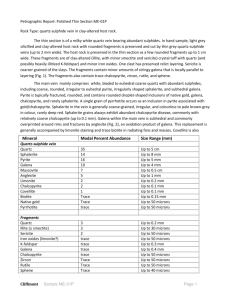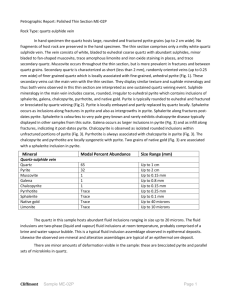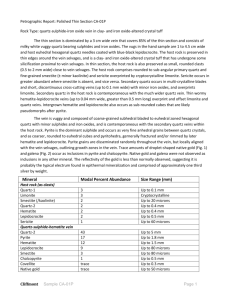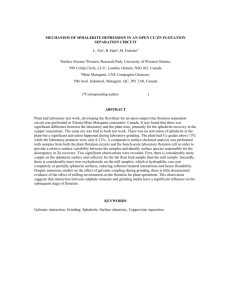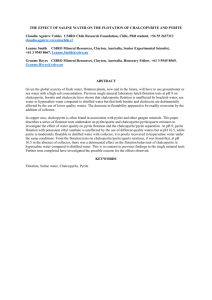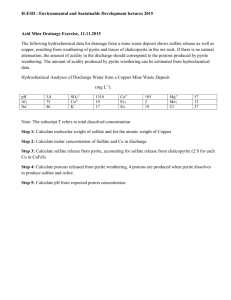SLD-08-02P psm
advertisement
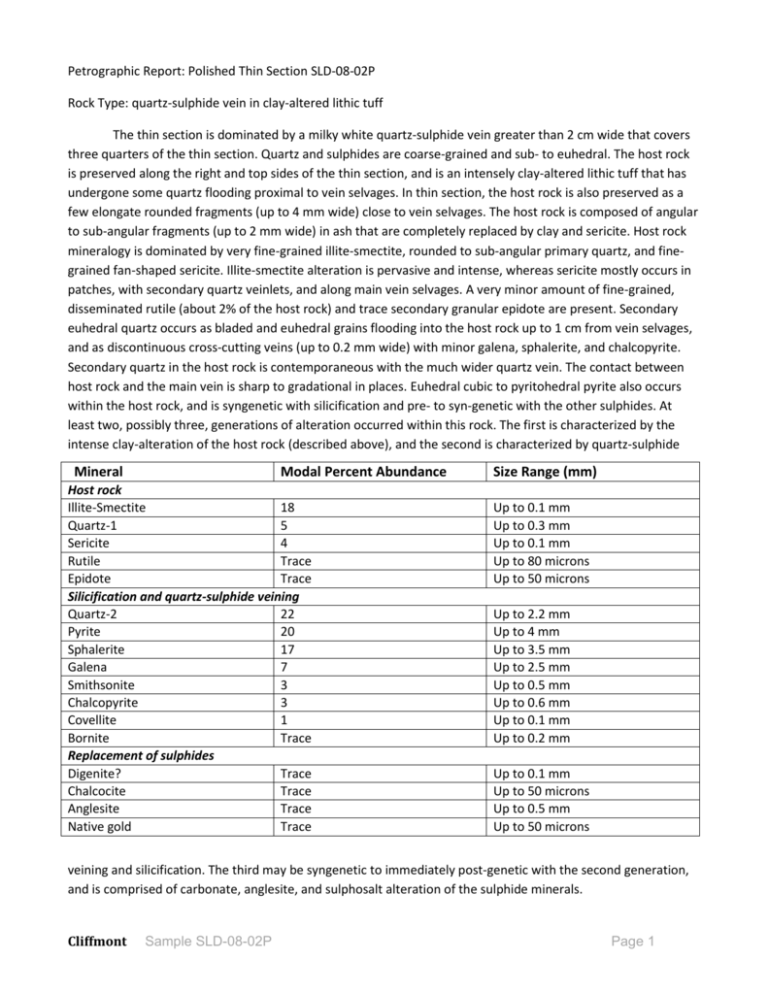
Petrographic Report: Polished Thin Section SLD-08-02P Rock Type: quartz-sulphide vein in clay-altered lithic tuff The thin section is dominated by a milky white quartz-sulphide vein greater than 2 cm wide that covers three quarters of the thin section. Quartz and sulphides are coarse-grained and sub- to euhedral. The host rock is preserved along the right and top sides of the thin section, and is an intensely clay-altered lithic tuff that has undergone some quartz flooding proximal to vein selvages. In thin section, the host rock is also preserved as a few elongate rounded fragments (up to 4 mm wide) close to vein selvages. The host rock is composed of angular to sub-angular fragments (up to 2 mm wide) in ash that are completely replaced by clay and sericite. Host rock mineralogy is dominated by very fine-grained illite-smectite, rounded to sub-angular primary quartz, and finegrained fan-shaped sericite. Illite-smectite alteration is pervasive and intense, whereas sericite mostly occurs in patches, with secondary quartz veinlets, and along main vein selvages. A very minor amount of fine-grained, disseminated rutile (about 2% of the host rock) and trace secondary granular epidote are present. Secondary euhedral quartz occurs as bladed and euhedral grains flooding into the host rock up to 1 cm from vein selvages, and as discontinuous cross-cutting veins (up to 0.2 mm wide) with minor galena, sphalerite, and chalcopyrite. Secondary quartz in the host rock is contemporaneous with the much wider quartz vein. The contact between host rock and the main vein is sharp to gradational in places. Euhedral cubic to pyritohedral pyrite also occurs within the host rock, and is syngenetic with silicification and pre- to syn-genetic with the other sulphides. At least two, possibly three, generations of alteration occurred within this rock. The first is characterized by the intense clay-alteration of the host rock (described above), and the second is characterized by quartz-sulphide Mineral Modal Percent Abundance Host rock Illite-Smectite 18 Quartz-1 5 Sericite 4 Rutile Trace Epidote Trace Silicification and quartz-sulphide veining Quartz-2 22 Pyrite 20 Sphalerite 17 Galena 7 Smithsonite 3 Chalcopyrite 3 Covellite 1 Bornite Trace Replacement of sulphides Digenite? Trace Chalcocite Trace Anglesite Trace Native gold Trace Size Range (mm) Up to 0.1 mm Up to 0.3 mm Up to 0.1 mm Up to 80 microns Up to 50 microns Up to 2.2 mm Up to 4 mm Up to 3.5 mm Up to 2.5 mm Up to 0.5 mm Up to 0.6 mm Up to 0.1 mm Up to 0.2 mm Up to 0.1 mm Up to 50 microns Up to 0.5 mm Up to 50 microns veining and silicification. The third may be syngenetic to immediately post-genetic with the second generation, and is comprised of carbonate, anglesite, and sulphosalt alteration of the sulphide minerals. Cliffmont Sample SLD-08-02P Page 1 The second generation of alteration is composed of silicification of the host rock and contemporaneous quartz-sulphide veining. The main vein is vuggy in places in the hand sample and composed of coarse-grained sub- to euhedral hexagonal, zoned quartz with abundant sulphides. It is contemporaneous with the thinner secondary quartz veins within the host rock. Pyrite is the dominant sulphide and occurs as coarse, sub- to euhedral cubes and pyritohedra between quartz crystals. Pyrite is commonly fractured, and fractures are generally filled with other sulphide minerals, especially galena and chalcopyrite, indicating that pyrite crystallization just barely precedes other sulphides in the paragenetic sequence of vein mineralization. Pyrite grains are disseminated randomly throughout the vein and finer grained along vein selvages. Minor amounts of droplet shaped chalcopyrite and rare galena occur as inclusions in pyrite. Sphalerite is the second most abundant sulphide in the thin section, and occurs as coarse anhedral grains in the main vein, with ragged edges and fractures commonly replaced by covellite, and abundant chalcopyrite disease. There appears to be two intergrown sphalerite generations (Fig. 1): sphalerite 1 contains fewer, but generally coarser, inclusions of chalcopyrite and is pale brown in colour; and sphalerite 2 contains more abundant, finer grained chalcopyrite and is colourless. Galena occurs as anhedral, and rarely euhedral, irregular grains mostly within interstices between pyrite and sphalerite, and within fractures in pyrite. Galena has curved crystal faces in this section, which may indicate contamination by trace amounts of silver. Chalcopyrite occurs as abundant chalcopyrite disease in both sphalerites, as rounded inclusions in pyrite, and also as irregular grains interstitial to quartz. Rarely, chalcopyrite exhibits replacement by covellite around its rims, and this occurs mostly in chalcopyrite grains within quartz. Trace amounts of bornite occur within fractures in quartz and as inclusions in sphalerite. A single grain of native silver occurs along the edge of a sphalerite grain associated with galena. The possible third alteration event (which may actually be syngenetic with the veining event) is characterized by smithsonite-covellite and anglesite-sulphosalt alteration of sphalerite and galena. A dirty blackbrown, crustiform carbonate mineral occurs along grain boundaries between the two sphalerites and along fractures in sphalerite. Fine-grained covellite commonly replaces both sphalerite generations around fractures and sph-2 carb ang gn qtz sph-1 sph-1 Figure 1: Photomicrograph of the two intergrown sphalerites in this thin section: pale brown sphalerite 1 (sph-1), chalcopyrite-rich, colourless sphalerite 2 (sph2). A dark black-brown carbonate mineral occurs along fractures and grain boundaries of the two sphalerites. Photo taken in plane polarized transmitted light. Cliffmont Sample SLD-08-02P py Figure 2: Photomicrograph of galena (gn) in pyrite (py) being replaced by trace amounts of anglesite (ang) that cuts across the galena and pyrite. Photo taken in plane polarized reflected light. Page 2 grain edges, particularly where sphalerite is in contact with the carbonate. In places galena is replaced by trace amounts of anglesite that cuts across the galena and fractures (Fig. 2). Chalcocite and possibly digenite and rim galena, and rarely sphalerite, as amorphous, crustiform replacement from the outside of the grains inward. Native gold (Fig. 3) may be related to this possible third alteration event, and occurs with smithsonite and nettextured chalcocite intergrown with covellite where they replace sphalerite. Figure 3: Photomicrograph of a single grain of native gold (au) within smithsonite (sm) alteration of sphalerite (sph). Thin rims of fine-grained blue covellite (cv) and and intergrown chalcocite occur around relict sphalerite grains and disseminated through the carbonate. Photo taken in plane polarized reflected light. qtz py sm sph au cv Cliffmont Sample SLD-08-02P Page 3
